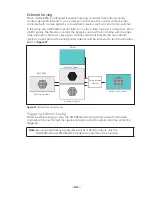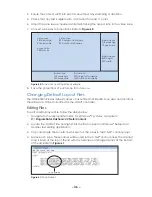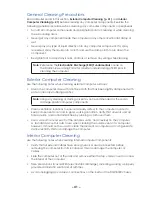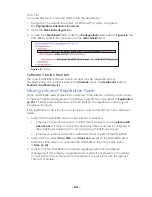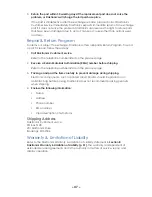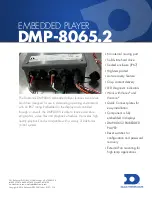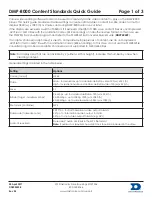
– 41 –
General Cleaning Precautions
Read all bullet points in this section,
Exterior Computer Cleaning (p. 41)
before cleaning any computer components. Exercise the
following general precautions when cleaning any computer components or peripherals:
• Turn off all computer components and peripherals prior to cleaning or while cleaning
the surrounding area.
• Never get any component inside the computer or any other circuit board damp or
wet.
• Never spray any type of liquid directly onto any computer component. If a spray
is needed, spray the liquid onto a cloth and use the damp cloth to rub down the
component.
• Be vigilant not to adjust any knobs, controls, or remove any wiring while cleaning.
Note:
Reference the
Electrostatic Discharge (ESD) Fundamentals
course on
the Daktronics Learning Portal for a better understanding of ESD prior to
cleaning the computer.
Exterior Computer Cleaning
Use the following notes when cleaning external computer surfaces:
• Clean the computer case with a lint-free cloth that has been slightly dampened with
water or isopropyl rubbing alcohol.
Note:
Using any cleaning or dusting solvents is not recommended as these can
damage plastic computer components.
•
Clean ventilation locations to ensure a steady airflow to the computer in order to
keep components cool and in good working condition. Verify that all vents and air
holes are lint- and contaminant-free by rubbing a cloth over them.
• Use a vacuum around each of the air holes, vents, and crevices on the computer.
A standard vacuum is safe to use when cleaning the outside vents of a computer;
however, it should not be used to clean the inside of a computer as it can generate
static electricity that can damage the computer.
Interior Computer Cleaning
Use the following notes when cleaning internal computer components:
• Verify that all external cables have enough slack or are disconnected before
removing the computer from its location as this can damage the computer or
cables.
• Slide the computer out of the rack and remove either the top or side cover to access
the interior of the computer.
• Take precautions to avoid ESD (electrostatic discharge), including wearing a properly
grounded anti-static wrist band at all times.
• Avoid unplugging any cables or connections on the inside of the DMP-8000 chassis.
Summary of Contents for DMP-8000 Series
Page 52: ...48 This page intentionally left blank...
Page 54: ...50 This page intentionally left blank...
Page 56: ......
Page 62: ...This page intentionally left blank...








